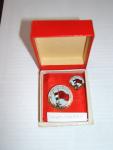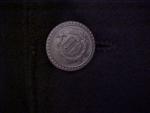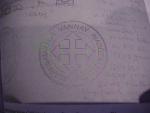-
Posts
4,807 -
Joined
-
Last visited
-
Days Won
12
Content Type
Profiles
Forums
Blogs
Gallery
Events
Store
Everything posted by Gordon Craig
-

Hungary Hungarian Kivalo Dolgozol Badges
Gordon Craig replied to hunyadi's topic in Central & Eastern European States
Gents, Time for me to add some pictures here instead of just text. Here are some case badges that I picked up during the week. First a cased set for Light Industry. More to follow after that. Sorry for the blurry images. My digital camera usually takes clearer pictures than my wife's and I usually use it but today my A drive died and my camera uses floppy disks so I had to use my wife's Cheers, Gordon -
Stan, Thanks for the response and the interesting history on Kunstmann. This tunic with the button hole for the AHG plus the loops for the horizontal pin version of the badge just goes to show that regardless of what collctors say is "the only way things were done" because of regs they have read just doesn't hold water. We are constantly finding uniforms like this one, plus pictures, that illustrate all kind of different way badges were worn. The day I bought my DAF uniform at The MAX was a good one for me!!!!!!! Regards, Gordon
-
Stan, Has your research on Kunstmann indicate that he also held a high rank in the DAF? My tunic does not have the loops for the pin on bdage that the one in this thread does and it is not named. It would nice to be at least able to "attribute" my DAF uniform to someone. Especially since these are the only two uniforms that I have seen with these "button holes" in these locations. Regards, Gordon
-

Hungary Hungarian People's Republic Awards
Gordon Craig replied to Ed_Haynes's topic in Central & Eastern European States
Ulsterman, That was an interesting article that you posted. I had posted another article on the same badges but not in that depth. I spent close to two hours with the present curator of Numismatics and Medals at the Hungarian Military Museum yesterday (14 Feb.). To say the least it was an interesting and enlightening visit. We were allowed to take photographs of some of the badges shown in the article with the express agreement that we use them only for our own research and not publish them on the internet or in any other form. This is not the forum to post information on WWII badges so I will not update the article here. Perhaps it would be a good idea to post it on the WWII forum and update the article there. There is new information to add on badges in the inventory of the museum. Before I do that though, I will wait until after my next visit on the 28th of Feb. The museum is only available to researchers on Wednesdays so we have to be patient!!!!! Regards, Gordon -
Joe W, No the buttonhole slot is qhite different from the round hole used for the screw backed badges. The slotted hole sgown in the picture exhibits much different characteristics than the round hole for the screw type badges. The slotted hole clearly shows that something has been inserted in the hole and turned were as the round holes stay the same shape because the shaft on the badge and the nut device that holds it in place to not p[ut any starin on the hole. Regards, Gordon
-

Hungary Hungarian People's Republic Awards
Gordon Craig replied to Ed_Haynes's topic in Central & Eastern European States
Zsolt, Thanks for the post. I visited the Military Museum this morning and they gave the same information but very kind of you to share you knowledge. We have come across two other markings for the Hungarian State Mint. Another one is P.V. which is found on a Free Fall Para badge in my collection and some other smaller badges plus a similar makring to the one I aksed about previously that only uses three letters which I think are MVP. Charles can confirm, or correct, that fact. Cheers, Gordon -

Hungary Hungarian People's Republic Awards
Gordon Craig replied to Ed_Haynes's topic in Central & Eastern European States
Richard S Thanks for posting your medals. I would like to have a silver one to add to my bronze. The reverse of the bronze caught my eye though. I had never noticed before, but on the reverse just to the right of where the sta is attached to the wreath there is a makers mark. It appears to be a small triangle with a star at the top inside the triangle. Along the inside of the base of the triangle it looks as thought the letters "MAZV" are printed. Can anyone else with one of these medals confirm those are the letters they see on the award in their collection? Does anyone know who the maker of these awards was? Cheers, Gordon -

Hungary Hungarian People's Republic Awards
Gordon Craig replied to Ed_Haynes's topic in Central & Eastern European States
Ulsterman, It would be nice if there were KISZ reference material all over the place but just ain't so! There are lots of KISZ badges, awards etc. available but no way to tell what they were awarded for. Like pulling teeth to find the info. You have to love the chase!!!!!!!!!!!!!!!!!!!! Cheers, Gordon -

Hungary Hungarian People's Republic Awards
Gordon Craig replied to Ed_Haynes's topic in Central & Eastern European States
Ulsterman, The KISZ badge is one of five awarded, yours being the top one. Starting with the number "1" they get progressively larger, have a wreath added etc. There is one more larger badge of the same design without a number that may be from the same series as it is of the same design pattern. I'm working on an article on KISZ and I'll save posting the series until then. By the way, I don't have a number five yet but I do have the rest of them. I spoke to the dealer I bought them from and he had been in KISZ but couldn't remember what they were awarded for. More research for the future! Cheers, Gordon -

Hungary Hungarian People's Republic Awards
Gordon Craig replied to Ed_Haynes's topic in Central & Eastern European States
Ulsterman, I assume you were referring to the star shaped badges? If so, those are the Killian Sports Badges. They are worn about the right breast pocket and exist in earlier versions. Here is a picture of one in the box of badges. Following that is the earlier version of the same badge from the Rakoci era on one of my tunics. There is an earlier version that I have only seen a line drawing of in the Hungarian Army Gazette. Regards, Gordon Sorry, they got posted in reverse order to the way I uploaded them. The badge with KTP at the bottom is the Killian badge. -

Hungary Hungarian Kivalo Dolgozol Badges
Gordon Craig replied to hunyadi's topic in Central & Eastern European States
Ulsterman, Good eyes! This guy must have been the workaholic of all time. Interesting that he engraved this one as well. These are indeed very impressive document holders. With the raised award on the surface and then the complex document itself they are a work of art. No doubt Charles will use his knowledge of Hungarian to answer the questions asked. Regards, Gordon -

Hungary The Hungarian Szocialista Brigade
Gordon Craig replied to Gordon Craig's topic in Central & Eastern European States
Jeff, There have been a couple of the Csendor annual books on ebay recently. One for 1907 that I was watching but didn't bid on because someone wanted it far more then I did. A couple of weeks ago a 1927 edition came up and I was able to successfully bid on that one as it went for approx half the price of the 1907 edition. As Charles says, there don't seem to be many of them around. Both Charles and I would like one from the war time period, or at least shortly before, and we will just have to keep looking. Regards, Gordon -
Gents, Last Saturday at the monthly Militaria Show here in Budapest I bought a uniform that the vendor said he "thought" was for a prison guard. During the week I have been researching a stamp that I found inside the tunic and on the outside of the pants. As is usual with stamps in uniforms it was not totally readable. I sought assistance from a Hungarian collector who has tentatively identified the stamp as reading "MEGYEI TBC GY?GYINT?ZET DOBA" and has translated that as "County Medical Institute for Tuberculosis". Doba is the name of a small town. I would ike to ask if anyone else out there knows anything about these uniforms. It is made from a heavy wool material usually associated with enlisted personnel rather than officers. It is a medium grey/blue colour. It has loops on the shoulders for shoulder boards but no buttons. Shoulderboards were held onto Hungarian uniforms in the early 50's using a manner that did not require the use of shoulder board buttons attahced to the tunic and this same system seems to have been used on this tunic. However, the style of the tunic and the crest on the buttons indicate use and manurfacture around the mid 60s. Pictures of the uniform, the buttons and the interior stamp are posted below.
-

Hungary The Hungarian Szocialista Brigade
Gordon Craig replied to Gordon Craig's topic in Central & Eastern European States
Charles, Nice looking banner. It makes wonder though if the Socialista Brigads had names as individual units or would they have used the company name? The Diploma that I have appears to be associated with the Posta Szervez. There are two stamps on the Diploma but part of each is obscured. I'll have to bring it with me sometime when we are getting together and perhaps, with your knowledge of Hungarian, you can figure out the parts I can not read. Perhaps on the 14th when we meet at the Museum. Regards, Gordon -

Hungary Hungarian Kivalo Dolgozol Badges
Gordon Craig replied to hunyadi's topic in Central & Eastern European States
Deker, Very nice badge thanks for the pictures. Charles, Thanks for the info. Cheers, Gordon -
Richard S, Thanks for adding the colour photos. Very nice closeups of the Hungarian badges on the space suits. I have to correct my earlier statement that Bertalan was wearing the Free Fall badge in an earlier picture that I posted. From these pictures it is easy to see he was wearing the Pilots Badge. I should have realized that before. Charles, Good question about the badge. It is probably a KISZ badge, like one of the suspension ones we saw at the show on Saturday, and someone has wiped out the badge because of the communist insignia. According to the 75 uniform regulations they were allowed to wear some KISZ badges/awards but there is no mention of permission to wear Red Cross awards. We can go through that tomorrow when I bring over that section of the 75 regs. Cheers, Gordon
-

Hungary Hungarian Kivalo Dolgozol Badges
Gordon Craig replied to hunyadi's topic in Central & Eastern European States
Gents, No one showed a "Sztahanavista" with numbers on the back. Mine isn't numbered. Were they? Cheers, Gordon -

Hungary Hungarian "Death Squad" Arrow Cross Brassard
Gordon Craig replied to Mike's topic in Central & Eastern European States
Charles, Great pictures. I've heard of KABSZ before but didn't realize it was as wide reaching s it appears to be from the photos you posted. Regards, Gordon -

Hungary Hungarian People's Republic Awards
Gordon Craig replied to Ed_Haynes's topic in Central & Eastern European States
Charles, Congratulations on going back and buying that matched set. A very nice addition to your collection! Something for me to shoot for! That is indeed an unusual catch. Don't believe I've seen that one before. Cheers, Gordon -

Hungary Hungarian "Death Squad" Arrow Cross Brassard
Gordon Craig replied to Mike's topic in Central & Eastern European States
Mike, Ah yes, Snider's Treasures". What an unusual chap! The arm band you mentioned could have been one of just a few made although from the sounds of it well made. I don't ever remember reading about anyone rounding up people after Operation Margarethe who wasn't wearing a black Arrow Cross uniform but then again there isn't a lot in print about them. The arrow cross stamps on documents awarding medals etc were certainly removed at the end of the war. I saw an award document for a Vitez at the December Militaria Show here in Budapest and in the location where the authorization stamp is normally placed there was just a neat round hole. Hopefully I will get to visit The House of Terror soon. My wife even mentioned visiting it this morning at breakfast! Strange coincidence? Just as an illustration of things that happened re the Arrow Cross in the last few months of the war, here is a picture of the Arrow Cross stamp that the Vannay Battalion used to authenticate their documents with the Arrow Cross. It wasn't an official stamp because there wern't any so they engraved their own. The photo is from Ervin Galantay's book "Boy Soldier". Regards, Gordon -

Hungary Hungarian "Death Squad" Arrow Cross Brassard
Gordon Craig replied to Mike's topic in Central & Eastern European States
Mike, Thanks for posting the pages from Bender's book. I am due for a visit to "The House Of Terror" on Andrasi ut and will move that up on my list of things to do soon. Since this address, 60 Andrasi, was the headquarters of the Arrow Cross before it became the headquarters of the AVH they might have some pictures showing this armband in wear. Regards, Gordon -

Hungary Hungarian Red Cross Awards
Gordon Craig replied to Gordon Craig's topic in Central & Eastern European States
Ulsterman, The website you posted is the one I refered to in my post. No guarantee that this medal is correct for that period but another piece of information. Send me Ms Koltai's phone number and email address and I'll contact her for you. Your interest in Red Cross medals has sparked my interest. In any countries military that I study I eventually get interested in the civilian uniforms. The military uniforms and medals etc. reflect the country but the civilian uniforms tend to do so even more so. In Hungary there is little to nothing known about civilian uniforms of the Communist era. To my sensabilities that is like waving a red flag in front of a bull. I just cannot resist a challenge and need to research those uniforms. I've already started on the firemen and Finance/Customs Guards uniforms and I hope I can move onto the the Parilamentary Guard soon. The Military Museum has one Postal uniform and that is it. Cheers, Gordon -

Hungary Hungarian "Death Squad" Arrow Cross Brassard
Gordon Craig replied to Mike's topic in Central & Eastern European States
Gents, It would be interesting to see one of these worn on a uniform. I am also curious as to why the crown is present on an Arrow Cross arm band. Here is a picture of the Arrow Cross insignia arm band being worn by Hungarian Officers shortly after the success of Operation MARGARETHE. Regards, Gordon










